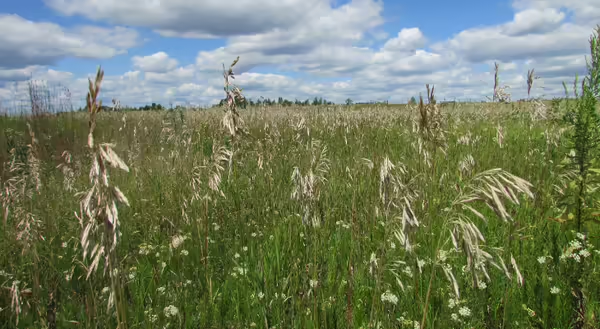
Last week I attended the North American Prairie Conference in Altoona, Iowa. Shoutout to the blog readers I met there! As is typical for me, on my drive to the conference I was identifying the plants I could see on the roadsides. One grass in particular was ubiquitous in the landscape – Smooth Brome, Bromus inermis. Looking up its distribution, I learned that you could find this grass in about 80% of the counties in Iowa. In Illinois, it's been reported in every county in the state! Sounds like something we should take a closer look at, right?
Smooth Brome is a cool-season, non-native grass. It was widely planted it as a forage grass, so it can be found in fields, prairie restorations, and disturbed habitats. When I was working to restore prairies in Minnesota, we were constantly trying to knock back the Smooth Brome grass.

How do we identify it?
One of about 20 species of Brome grasses, Smooth Brome grows about 3 feet tall. Its leaf blades can be a grayish-green on top and green below. They also have a zig-zag or m-shaped crimp in the middle of the leaf that you can feel if you run your fingers along the leaf blade. Smooth Brome has a membranous ligule too.
In the late fall, the leaves of Smooth Brome turn a straw color and curl tightly. The leaves then rustle in the wind, making this grass stand out from others in the area.

What do the spikelets look like?
Smooth Brome flowers in early summer, producing a panicle inflorescence. The spikelets are green to reddish in color, smooth, and elongated. While the spikelets of most Brome grasses have awns, Smooth Brome does not. After blooming, the branches of Smooth Brome’s panicles often contract and then the whole seed head curves to the side.
Never miss a new post! Sign up for our email list.
ABOUT THE AUTHOR: Erin Garrett is a Natural Resources, Environment, and Energy Educator for University of Illinois Extension serving Alexander, Johnson, Massac, Pulaski, and Union counties. Erin develops and delivers high impact programming to adults and youth to help them develop an appreciation for natural resources and to empower them to make small changes to positively impact the environment. Erin’s programming focuses on why homeowners should consider choosing native plants, how to support native pollinators, how to identify grasses, how to identify and manage invasive species, and developing an appreciation for prairie ecosystems.
ABOUT THE BLOG: Grasses at a Glance dives into grass identification, focusing on tips and tricks that make grass identification possible. Get information about native and non-native species, how to tell look-alikes apart, and which grasses you can find in Illinois.
Smooth Brome, Bromus inermis, is a non-native, cool season grass found throughout Illinois. It grows between two and four feet tall, and it produces rather weak, broad leaves that have an m-shaped crimp across the blades, which you can feel if you run the blade between your fingers. It...